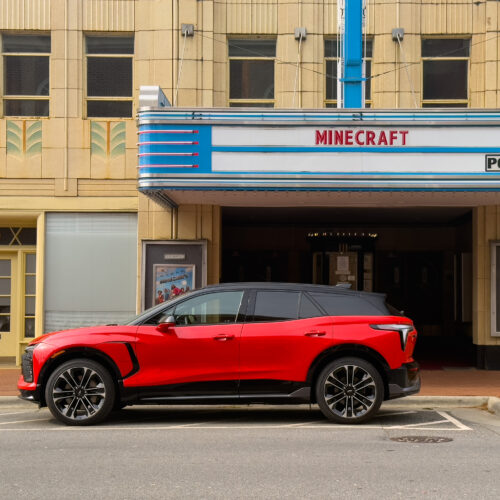Skip to content
It’s not a track car, but we drove it on a track.
The colleague I shared this Blazer EV with compared it to a Camaro SUV, and that’s actually a pretty good take, I think. Anyway, this version goes faster but more importantly rides much better.
Credit:
Jonathan Gitlin
The colleague I shared this Blazer EV with compared it to a Camaro SUV, and that’s actually a pretty good take, I think. Anyway, this version goes faster but more importantly rides much better.
Credit:
Jonathan Gitlin
CHARLOTTE, North Carolina — Before letting us loose on the freshly laid tarmac of Ten Tenths Motor Club, Chevrolet was at pains to tell us that the new Blazer SS “is not a track car.” Sure, there’s a “competitive mode” to the suite of electronic settings and the fastest 0–60 mph time of any SS-badged Chevy to date. The upgrades have been focused on making the Blazer EV “stop, go, and turn” better, and you don’t need to be driving hard to appreciate the benefits.
The Blazer EV had a rocky start. When we first drove it at the end of 2023, it felt a little unfinished, and a few days later unreliable software stranded another journalist and led to a nationwide stop-sale on the then-new EV. By last March, the software was fixed and the Blazer EV was back on sale, now cheaper than before.
Watts new?
While other Blazer EVs are available with front- or rear-wheel powertrains or with a smaller battery pack, the SS only comes with all-wheel drive and the larger 102 kWh battery pack. Nominal power output is 515 hp (384 kW) and 450 lb-ft (610 Nm), which jumps to 615 hp (458 kW) and 650 lb-ft (880 Nm) if you engage the “Wide Open Watts” mode.
The styling changes for the SS trim are subtle.
Jonathan Gitlin
The battery chemistry is the same as lesser Blazers, but the SS makes good use of new silicon carbide inverters in the rear drive unit that minimize energy losses and segmented magnets in the motors that reduce heat buildup. There are bigger brakes, better tires, and the suspension benefits from stiffer anti-roll bars and springs, a faster steering ratio, and new monotube dampers that (together with the springs) do a far better job of controlling the Blazer’s ride than the bits fitted to the Blazer EV RS I last drove.
Oftentimes, the performance variant of an EV suffers from reduced range as a consequence of the added power and bigger wheels. But the Blazer EV SS still manages an EPA range estimate of 303 miles (488 km), significantly better than the less powerful AWD option (which uses the smaller 85 kWh battery pack). DC fast-charging maxes out at 190 kW—I’d love to give you a 10–80 percent fast-charge time, but Chevy only quotes “78 miles in 10 minutes” when it comes to charging stats.
AC charging tops out at 11.5 kW, and the Blazer EV SS is capable of vehicle-to-home charging, although that requires compatible charging hardware from GM Energy. And while Tesla’s Supercharger stations now show up in the onboard Google Maps navigation system—including their status—you’ll still need to use an adapter to charge at one, because the car’s charge port remains CCS1.
I am told that if you pushed this beyond the limit of the tires, you’d find understeer.
Jonathan Gitlin
The Blazer EV was one of the first of Chevy’s CarPlayless infotainment systems. We thought that dropping the phone casting interface was a mistake when we reviewed the car last year, and it remains a bugbear among readers, if feedback in the comments is anything to go by. But the infotainment in the Blazer EV SS has a few new tricks (that will roll out to other Blazers in time). In addition to better route planning that can even factor in which roads allow you to activate Super Cruise, while the car is parked, you can now stream video from platforms like Peacock, Max, and Amazon Prime, which should come in handy during charging stops.
When the tires start singing, you should listen to them
On track, I heeded Chevy’s warnings and drove the Blazer EV SS about as fast as I felt comfortable, up to but not past the tires’ available grip. You have to listen for it, rather than feel it through the numb steering—the tires begin to “sing” as they start to lose grip, which is a good signal to lift off the throttle some. Despite its curb weight of 5,730 lbs (2,600 kg), the SUV coped well with the elevation and camber changes at Ten Tenths, although you remain conscious of that mass when it’s time to slow for the corners. But the main thing that keeps your speeds sane is the unsupportive seats, which lack any extra side bolstering compared to the standard Blazer.
Chevy quotes a 0–60 mph time of 3.4 seconds—the slight downhill gradient to the section of test track we used to test launch control might have helped contribute to our 3.3-second time. The company wasn’t joking about this being the fastest-accelerating SS-badged Chevrolet yet. While no one should take a Blazer EV SS to a track day, it handled the whole affair much more composure than the Dodge Charger EV managed on a much less rigorous circuit. The entire drive was also free of the bugs and gremlins that have become an all-too-common part of driving new EVs.
There are several levels of lift-off regen braking available, from almost none to 0.3 G in the highest setting, which I find most appropriate for city driving or a twisty road. The people responsible for calibrating the control inputs deserve some praise here, because the throttle mapping is wonderfully intuitive and feels extremely natural to drive in one-pedal mode. Despite such prodigious power and torque levels, even in the more aggressive Sport or Z modes, the initial throttle tip-in is unlikely to smash your passengers’ heads back into their seats unless that’s what you’re trying to do, something that powerful electric SUVs from other automakers can’t always claim.
At $60,600, the Blazer EV SS has entered what is now quite a competitive segment. The most obvious rival is the Ford Mustang Mach-E, either in Mach-E GT or Mach-E Rally form; both are cheaper than the Blazer EV, but neither has its range. There’s also the Kia EV6 GT, but that struggles to make it much more than 200 miles on a charge, and it’s not really any more fun than the normal EV6. For all-out electric fun, my money would still be on the Hyundai Ioniq 5 N, which is a few thousand dollars more but remains the best thing I drove last year.
Jonathan is the Automotive Editor at Ars Technica. He has a BSc and PhD in Pharmacology. In 2014 he decided to indulge his lifelong passion for the car by leaving the National Human Genome Research Institute and launching Ars Technica’s automotive coverage. He lives in Washington, DC.
139 Comments












